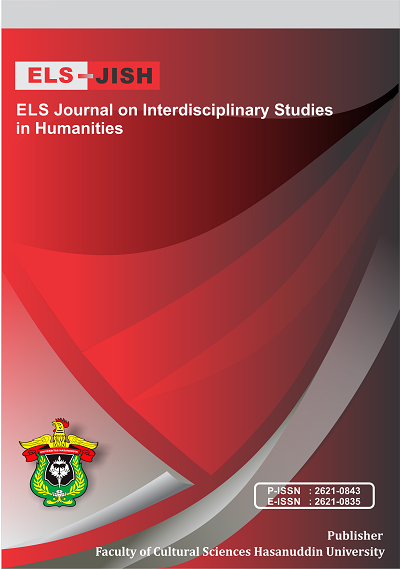The Impact of English as a Medium Instruction (EMI) on English Language Skills Development in Business Administration Students
DOI:
https://doi.org/10.34050/elsjish.v7i2.35249Keywords:
English as a Medium Instruction (EMI), Improvement, Language skillsAbstract
The objectives of this study were to find out whether the use of English as a Medium of Instruction (EMI) was effective in improving the English Language of Students majoring in Business Administration and to analyse the factors that influence the effectiveness of English as a medium Instruction (EMI) in improving the English Language Skills of Students majoring in Business Administration. This study employed qualitative research which the data was collected using observation and interviews. The collected data was interpreted qualitatively. This study employs purposive sampling. Class II MB 6 and IV MB 6 were the population and IV MB 6 was the sample with 30 students. The finding showed that implementing EMI can improve some aspects of English language skills, namely speaking and listening. On the other hand, some difficulties in understanding the topic delivered occurred. The factors that influence the effectiveness of English as a medium of Instruction (EMI) in improving English Language Skills are the Frequency of using English, the Frequency of listening to English speakers, and the interaction of the students with their classmates where they need to speak English during the classroom activity.
References
Aswad, M., Rahman, F., Said, I. M., Hamuddin, B., & Nurchalis, N. F. (2019). A software to increase English learning outcomes: An acceleration model of English as the second language. The Asian EFL Journal, 26(6.2), 157.
Byun, K., Chu, H., Kim, M., Park, I., Kim, S., & Jung, J. (2011). English medium teaching in Korean higher education: Policy debates and reality. Higher Education, 62(4), 431-449.
Dearden, J. (2014). English as a medium of instruction – A growing global phenomenon. University of Oxford.
Dearden, J. (2015). English as a medium of instruction -a growing global phenomenon. London: British Council.
Fenton-Smith, B., Humphries, P. & Walkinshaw, I. (2017). English medium instruction in higher education in Asia Pacific: From policy to pedagogy. Dordrecht: Springer
Huang, Y. P. (2013). Design and implementation of English-medium courses in higher education in Taiwan: A qualitative case study. English Teaching & Learning, 36(1), 1-51.
Ibrahim, J. (2001). The Implementation of EMI (English Medium Instruction) in Indonesian Universities: Its Opportunities, its Threats, its Problems, and its Possible Solutions. Universitas Kristen Petra.
Junaid, S., Nahdhiyah, N., Dahlan, D., Andini, C., & Dzulhijjah, A. M. (2024). The Portrayal of African Woman’s Struggle Reflected in the Novel “How Beautiful We Were” By Imbolo Mbue (2021). ELS Journal on Interdisciplinary Studies in Humanities, 7(2), 275-284.
Martin, P. (2003). Bilingual Encounters in the Classroom. In Dewaele, J.M., Alex Housen & Li Wei (eds) Bilingualism: Beyond Basic Principles. Sydney: Multilingual Matters Ltd.
Paris, N., Samad, P., & Rauf, F. A. (2022). The Use of English Medium Instruction on Efl Students at Tertiary Education Level. Inspiring: English Education Journal, 5(2), 94-102.
Prihandoko, L. A., Tembang, Y., Marpaung, D. N., & Rahman, F. (2019). English language competence for tourism sector in supporting socio-economic development in Merauke: A Survey Study. In IOP Conference Series: Earth and Environmental Science (Vol. 343, No. 1, p. 012170). IOP Publishing.
Rahman, F. (2018). The constraints of foreign learners in reading English literary works: A case study at Hasanuddin University. Journal of Arts and Humanities, 7(2), 01-12.
Saeed, A., & Jarwar, A. Q. (2012). Impact of medium of instruction on achievement Level of Students at HigherSecondary Stages in Hyderabad Region of Sindh. Interdisciplinary Journal of Contemporary Research in Business, 4(4), 805-811.
Sosrohadi, S., & Nur, T. (2020). Kesinambungan Bahasa Ibu dan Loyalitas Penutur Bahasa Melayu Betawi di Setu Babakan: Kajian tentang Pemertahanan Bahasa. Populis: Jurnal Sosial dan Humaniora, 5(2), 260-272.
Wilang, J. D., & Nupong, S. (2022). Factors affecting EMI attitudes of engineering and nursing students. Theory and Practice in Language Studies, 12(3), 437-446.
Youngsun, K., Sosrohadi, S., Andini, C., Jung, S., Yookyung, K., & Jae, P. K. (2024). Cultivating Gratitude: Essential Korean Thankfulness Phrases for Indonesian Learners. ELS Journal on Interdisciplinary Studies in Humanities, 7(2), 248-253.
Downloads
Published
How to Cite
Issue
Section
License
Copyright (c) 2024 Reski Amalia S, Walangitan Melania Rut

This work is licensed under a Creative Commons Attribution-ShareAlike 4.0 International License.






